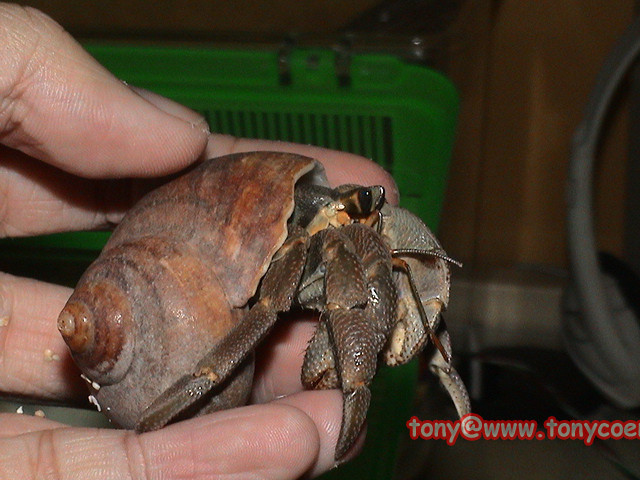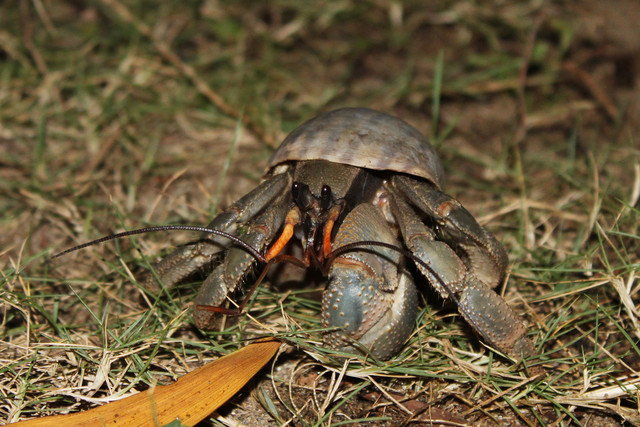カテゴリー「種類研究」の記事一覧
- 2025.11.06 [PR]
- 2010.07.31 Is new species Coenobita Brunneus identified officially?
- 2010.06.18 橙紅陸寄居蟹(Coenobita perlatus)與蠑螺
- 2010.04.03 灰白陸寄居蟹(Coenobita rugosus)??
- 2009.10.30 關於野外橙紅陸寄居蟹(Coenobita perlatus)的論文
- 2007.12.02 日本的分類學
[PR]
×
[PR]上記の広告は3ヶ月以上新規記事投稿のないブログに表示されています。新しい記事を書く事で広告が消えます。
Is new species Coenobita Brunneus identified officially?
又發現新品種? 其實這已是2010年3月的事了......叫做Coenobita Brunneus.

業者聲稱已為此新品種作了DNA測試, 證明了是新品種.
不過我自己卻滿心懷疑, 因為看圖片真的很像之前飼養的褐色體色的灰白陸寄居蟹......


是否業者又收集了一些較特別顏色的個體, 當作新品種出售!?
去信詢問過業者, 為何不把新品種公開給學者或有關科學家判決, 但沒有回覆.
業者聲稱已為此新品種作了DNA測試, 證明了是新品種.
不過我自己卻滿心懷疑, 因為看圖片真的很像之前飼養的褐色體色的灰白陸寄居蟹......
是否業者又收集了一些較特別顏色的個體, 當作新品種出售!?
去信詢問過業者, 為何不把新品種公開給學者或有關科學家判決, 但沒有回覆.
PR
橙紅陸寄居蟹(Coenobita perlatus)與蠑螺
通常有蟹友問, 橙紅背甚麼螺殼, 我會說蠑螺.
在此說聲對不起, 因為忽略了個體的大小.
最近看了一篇文獻, 講述個體小的橙紅陸(前甲長<8mm)反而會偏向背長型的螺殼, 到了中型和大型時, 才會以銀口蠑螺為主.
引述:
"The smallest size class (all C. rugosus and C. perlatus, < 8mm C.L.) used the greatest number of shell species (63) .
在此說聲對不起, 因為忽略了個體的大小.
最近看了一篇文獻, 講述個體小的橙紅陸(前甲長<8mm)反而會偏向背長型的螺殼, 到了中型和大型時, 才會以銀口蠑螺為主.
引述:
"The smallest size class (all C. rugosus and C. perlatus, < 8mm C.L.) used the greatest number of shell species (63) .
Fewer shell species were used with increasing hermit crab size. On all islets combined the shell species diversity index of C. perlatus decreased from 2.90 for the smallest crabs ( < 8 mm C'L) to 0.09 for the largest hermit crabs ( > 19mm c.L.). Large crabs also used different shell species than smaller crabs (Tables 2A, B, C). Rhinoclavis sinensis was the shell most commonly used by the smallest size class , while virtually all (98 percent) of the largest crabs were found in Turbo argyrostomus."
詳細看此: http://www.tonycoenobita.com/Patterns.pdf
表2A, 顯示小型橙紅(前甲長<8mm)所選用的螺殼, 種類繁多.

表2B&C, 顯示中型(前甲長8-10mm)及大型橙紅(前甲長>19mm)所選用的螺殼, 超過9成以上是用銀口蠑螺.

銀口蠑螺
詳細看此: http://www.tonycoenobita.com/Patterns.pdf
表2A, 顯示小型橙紅(前甲長<8mm)所選用的螺殼, 種類繁多.
表2B&C, 顯示中型(前甲長8-10mm)及大型橙紅(前甲長>19mm)所選用的螺殼, 超過9成以上是用銀口蠑螺.
銀口蠑螺
http://catalog.digitalarchives.tw/dacs5/System/Exhibition/Detail.jsp?OID=523299
看完後, 才覺得 "對呀, 的確不論看業者的橙紅和野外的橙紅照片, 較小的個體都不常背蠑螺類, 中大型個體大多一式一樣背銀口蠑螺"
當然, 這是以文獻所調查的地方為例子, 螺殼種類會與當地的供應有很大關係.
不過大家也可以作為參考.
看完後, 才覺得 "對呀, 的確不論看業者的橙紅和野外的橙紅照片, 較小的個體都不常背蠑螺類, 中大型個體大多一式一樣背銀口蠑螺"
當然, 這是以文獻所調查的地方為例子, 螺殼種類會與當地的供應有很大關係.
不過大家也可以作為參考.
灰白陸寄居蟹(Coenobita rugosus)??
大家看以下圖片, 會猜以下是甚麼品種?


有時圖片的角度會很難拍到陸寄居蟹的左螯腳有沒有斜向夥粒, 所以很難確實地判斷是甚麼品種.
大家可以憑以下2點來判斷:
有時圖片的角度會很難拍到陸寄居蟹的左螯腳有沒有斜向夥粒, 所以很難確實地判斷是甚麼品種.
大家可以憑以下2點來判斷:
1. 身體的顆粒是偏向較大的, 尤其是在腕節上(紅圈處)的顆粒, 大而分佈得較疏
2. 眼柄(紅圈處)的黑斑範圍較廣


細仔看看之下便能夠清楚分別這兩品種了.
答案:
細仔看看之下便能夠清楚分別這兩品種了.
答案:
關於野外橙紅陸寄居蟹(Coenobita perlatus)的論文
自參考外國蟹友的意見後, 也認同橙紅陸寄居蟹(Coenobita perlatus)海水需求度高, 而且應該和牠們棲身於較近海邊, 經常出沒海邊有關, 可是一直未找到更多的相關資料, 例如學者的研究論文.
近日在討論區有蟹友討論橙紅陸寄居蟹的另類飼養方法(用淺海水飼養), 也談及牠們的野外實際環境及海水需求度.
http://www.tonycoenobita.com/discuz/viewthread.php?tid=1143&extra=page%3D1
終於在前天在網上找到三篇關於野外橙紅陸寄居蟹的文獻, 可以有多一點的資料去了解牠們的野外生態, 攝取較多海水的原因, 及進食活動.
以下我把重點的資料和大家分享(依論文推出年度):
終於在前天在網上找到三篇關於野外橙紅陸寄居蟹的文獻, 可以有多一點的資料去了解牠們的野外生態, 攝取較多海水的原因, 及進食活動.
以下我把重點的資料和大家分享(依論文推出年度):
*欲看完整論文請到http://www.tonycoenobita.com/article.htm
WATER BALANCE IN ANOMURAN LAND CRABS ON A DRY ATOLL (1964)
Gross ( 1955) demonstrated in laboratory experinients that the anomuran cocoanut crab, Birgus latro, can control its blood concentration by selecting water of appropriate salinity, and when given a choice it willvisit fresh water more often than sea water. Gross and Holland ( 1960) , on theother hand, demonstrated a similar behavioral mechanism in the hermit crab,Coenobita perlatus, but this species showed a definite preference for sea water overfresh water when offered a choice.
Coenobita perlatus is more common and less discriminating than the other two species in its choice of habitat. It is found in such extremes as exposed positions at the edge of the lagoon and protected conditions, such as the interior of piles of cocoanuts in wooded areas.
Serum osmotic concentrations for C. perlatus taken in the field were usually hypertonic to the available sea water and ranged from 102% sea water (cocoanut piles) to 150% sea water (active at night in forest).
Coenobita perlatus was observed to enter sea water and brackish water at night; this resulted in filling their adopted shells with water.
Distribution Patterns of Terrestrial Hermit Crabs at Enewetak Atoll, Marshall Islands (1982)
WATER BALANCE IN ANOMURAN LAND CRABS ON A DRY ATOLL (1964)
Gross ( 1955) demonstrated in laboratory experinients that the anomuran cocoanut crab, Birgus latro, can control its blood concentration by selecting water of appropriate salinity, and when given a choice it willvisit fresh water more often than sea water. Gross and Holland ( 1960) , on theother hand, demonstrated a similar behavioral mechanism in the hermit crab,Coenobita perlatus, but this species showed a definite preference for sea water overfresh water when offered a choice.
Coenobita perlatus is more common and less discriminating than the other two species in its choice of habitat. It is found in such extremes as exposed positions at the edge of the lagoon and protected conditions, such as the interior of piles of cocoanuts in wooded areas.
Serum osmotic concentrations for C. perlatus taken in the field were usually hypertonic to the available sea water and ranged from 102% sea water (cocoanut piles) to 150% sea water (active at night in forest).
Coenobita perlatus was observed to enter sea water and brackish water at night; this resulted in filling their adopted shells with water.
Distribution Patterns of Terrestrial Hermit Crabs at Enewetak Atoll, Marshall Islands (1982)
Coenobita perlatus were much more abundant than C. rugosus on the beach (Table 1a).
Small individualS « 8.0 mm CL, white in coloration with dark bands on the legs) were found not only under debris in the wrack zone, but frequently withdrawn into their shells exposed to the direct sun. During the night, large C. perlatus (2:: 20 mm CL, red in color) were also present on the beach. Medium-size C. perlatus (8-19 mm CL, varying in color from white to red) were much less numerous than small and large crabs.
The number of shell species used decreased dramatically with increasing crab size so that virtually 100 percent of the C. perlatus individuals> 12 mm CL were either in Turbo setosus 圓蝾螺or T. argyrostomus shells 銀口蠑螺.
The smallest crabs were closest to the beach, while large individuals were present on the beach as well as in the interior. The association of the small C. perlatus primarily with beach and nearshore habitat may be linked with the shell water requirements of this species. Coenobita perlatus prefers seawater over fresh water when filling its shell (Gross and Holland 1960) and usually has field blood serum concentrations hypertonic to seawater (Gross 1964). Two explanations for their distribution appear possible: (1) small individuals may need to replenish their shell water from the lagoon more frequently than medium and large individuals; and (2) small crabs possess more rigid osmoregulatory 調控滲透壓的 requirements than large individuals, utilizing only seawater to fill their shells.
Feeding Activity Patterns and Carrion Removal by Terrestrial Hermit Crabs at Enewetak Atoll, Marshall Islands! (1983)
Small individualS « 8.0 mm CL, white in coloration with dark bands on the legs) were found not only under debris in the wrack zone, but frequently withdrawn into their shells exposed to the direct sun. During the night, large C. perlatus (2:: 20 mm CL, red in color) were also present on the beach. Medium-size C. perlatus (8-19 mm CL, varying in color from white to red) were much less numerous than small and large crabs.
The number of shell species used decreased dramatically with increasing crab size so that virtually 100 percent of the C. perlatus individuals> 12 mm CL were either in Turbo setosus 圓蝾螺or T. argyrostomus shells 銀口蠑螺.
The smallest crabs were closest to the beach, while large individuals were present on the beach as well as in the interior. The association of the small C. perlatus primarily with beach and nearshore habitat may be linked with the shell water requirements of this species. Coenobita perlatus prefers seawater over fresh water when filling its shell (Gross and Holland 1960) and usually has field blood serum concentrations hypertonic to seawater (Gross 1964). Two explanations for their distribution appear possible: (1) small individuals may need to replenish their shell water from the lagoon more frequently than medium and large individuals; and (2) small crabs possess more rigid osmoregulatory 調控滲透壓的 requirements than large individuals, utilizing only seawater to fill their shells.
Feeding Activity Patterns and Carrion Removal by Terrestrial Hermit Crabs at Enewetak Atoll, Marshall Islands! (1983)
Large C.perlatus fed only at night and had the greatest impact on the carrion. Although small Coenobita had little effect on the carrion, their feeding activity did reduce the number offly maggots in the carrion.
Coenobita c. perlatus and C.rugosus) were observed eating Scaevola fruit 草海桐果實, Morinda fruit 雞眼藤果實 , coconut meat , coconut husk s, and the insides of a fallen coconut tree. Hermit crabs also fed on organic material that washed up on the beach. This included Laurencia sp. (a small ufted red alga 紅海藻), Halimeda sp. (corraline alga 鈣化藻), a dead subtidal bra chyuran crab, and a dead coconut crab, Birgus latro . Small Coenobita individuals were also observed feeding on bird feces.
Throughout the night large Coenobita perlatus fed on the bird , and by the next morning only feathers and bone remained.
Coenobita c. perlatus and C.rugosus) were observed eating Scaevola fruit 草海桐果實, Morinda fruit 雞眼藤果實 , coconut meat , coconut husk s, and the insides of a fallen coconut tree. Hermit crabs also fed on organic material that washed up on the beach. This included Laurencia sp. (a small ufted red alga 紅海藻), Halimeda sp. (corraline alga 鈣化藻), a dead subtidal bra chyuran crab, and a dead coconut crab, Birgus latro . Small Coenobita individuals were also observed feeding on bird feces.
Throughout the night large Coenobita perlatus fed on the bird , and by the next morning only feathers and bone remained.
日本的分類學
前天終於收到了日本沖繩圖書館寄來的三份資料.


<沖繩的自然百科19-陸寄居蟹>, 圖書館人員給我影了彩圖, 真的要謝謝他.

<沖繩縣天然紀念物系列第29集-陸寄居蟹生息實態調查報告>

<沖繩縣天然紀念物系列第43集-陸寄居蟹生息實態調查報告II>
看了<沖繩縣天然紀念物系列第29集-陸寄居蟹生息實態調查報告>有關分類的資料, 日本早在1987年已經把沖繩本地發現的, 灰白陸寄居蟹, 紫陸寄居蟹, 短腕陸寄居蟹, 橙紅陸寄居蟹, 凹足陸寄居蟹, 深紫陸寄居蟹, 這6種品種作了詳盡的分類.
書中也有提及深紫陸之前一直便誤會為凹足這個問題. 日本向來做事也十分細仔, 要研究的東西往往會很專門地研究, 很細仔地分析. 這點真是值得學習.
我也要好好利用聖誕節假期來閱讀那三本書......
另外, 對於<台灣寄居蟹類誌>書中, 為何沒有了凹足陸寄居蟹, 那深紫陸的圖片卻又像凹足陸寄居蟹, 這些問題已經去信詢問一了陳天任教授, 希望會有回覆.
<沖繩的自然百科19-陸寄居蟹>, 圖書館人員給我影了彩圖, 真的要謝謝他.
<沖繩縣天然紀念物系列第29集-陸寄居蟹生息實態調查報告>
<沖繩縣天然紀念物系列第43集-陸寄居蟹生息實態調查報告II>
看了<沖繩縣天然紀念物系列第29集-陸寄居蟹生息實態調查報告>有關分類的資料, 日本早在1987年已經把沖繩本地發現的, 灰白陸寄居蟹, 紫陸寄居蟹, 短腕陸寄居蟹, 橙紅陸寄居蟹, 凹足陸寄居蟹, 深紫陸寄居蟹, 這6種品種作了詳盡的分類.
書中也有提及深紫陸之前一直便誤會為凹足這個問題. 日本向來做事也十分細仔, 要研究的東西往往會很專門地研究, 很細仔地分析. 這點真是值得學習.
我也要好好利用聖誕節假期來閱讀那三本書......
另外, 對於<台灣寄居蟹類誌>書中, 為何沒有了凹足陸寄居蟹, 那深紫陸的圖片卻又像凹足陸寄居蟹, 這些問題已經去信詢問一了陳天任教授, 希望會有回覆.
CATEGORY
最新記事
(05/06)
(02/17)
(01/29)
(01/19)
(01/18)
